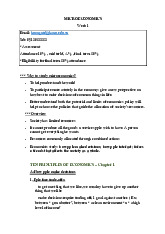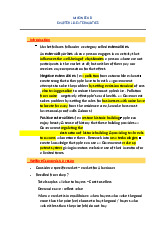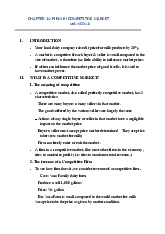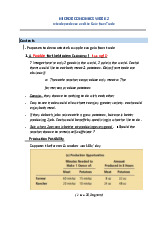









Preview text:
lOMoAR cPSD| 59114765 -
CONSUMERS, PRODUCERS, AND THE EFFICIENCY OF MARKETS Microeconomics week 6 1. Consumer Surplus Willingness to pay
- You own a mint-condition recording of Elvis Presley’s 1st album ut
you’re not fan hold auction - 4 fans show up for the auction
- But the amoutn each id willing to pay for it is limited
- Maximum price a buyer would buy called his willingness to pay , it
measures how much that buyers value the good - Progress
+ Bidding price at start at $10
+ All 4 buyers are willing to pay much more to own the album, the
price rises quickkly n stops when John bid $80+ ( or slightly more )
- John is willing to pay %100 for the albu but actually pays onlyy
$80 Hw recieves surplus is $20
- Consumer surplus = amount a buyer is willing to buy for a good –
amount that buyer actually pay for it
- Consumer surplus measures the benefits buyer receives from participating in a market
- If u have 2 identical album, not 1. Again u auction them off for the 4 possible buyers lOMoAR cPSD| 59114765 -
Bidding stops when John n Paul bid $70 ( or a bit more ). The other 2
are ot willing to bis any higher
+ John’s consumer surplus is $ 30
+ Pauls consumer surplus is $10
Total consumer surplus in the market is: $30+ $10= $40
Using the Demand Curve to measure Consumer Surplus lOMoAR cPSD| 59114765 - lOMoAR cPSD| 59114765 -
Lesson applied to all demand curves: The area below the demand
curve n above the price measures the consumer surplus in a market
How a Lower price raises cnsumer surplus
What does consumer surplus measure lOMoAR cPSD| 59114765 -
Consumer surplus, amount buyers are willing to pay minus amount they
actually buy, , measures the benefit that buyers receive from a good as the
buyers themselves perceive it.
- In some cirucmstances, policy markers mmight choose not yo care
about consumer surplus bcs they do not respect the preferences that drive buyer behvior
- From the standpoint of society, in this ex
+ Willingness to pay is Not a measure of the buyers’s benefit, and
+ Consumer surplus is not a good measure od economics wellbeing, because
addicts are not looking after their own best interests.
In most markets, however, consumer surplus does reflect economic well-
being. Economists normally assume that buyers are rational when they
make decisions. Rational people do the best they can to achieve their
objectives, given their opportunities.
Cost and the willingness to sell
- Each painters is willing to take the job if the price she would receive
is larger than her cost o doing this work
- Cost should be interpreted as Opportunity Cost : the value of
everything a seller must give up to produce a good
- Grandma is happy to do the job for $600 as bid, bcs her cost is $500 only.
- Grandma;s willing to do the work for $500 but gets $600 for doing it
She receive producer surplus of $100
- Producer surplus: the amount a seller is paid for a good minus the
seller’s cost of providing it
If you have 2 houses that need paiting, again you auction off the job to the 4 painters
- The bidding stops at each offer for $800. Georgia n Grandma are
willing to do the work at this price, the 2 others are nmot - At the price of $800
+ Grand receiveds producer surplus of $300
+ Georgia receive producer surplus of $200
The total producer surplus in the market is $500
- The lesson from this example applies to all supply curves: The area
below the price and above the supply curve measures the producer surplus in a market.
- Seller always want to receive a higher price
How a higher price raises producer surplus 2. Market Effiency
The Benevolent Social Planner
- Benevolent Socila planner is an all-knowing, all-powerful, wellintentioned dictators
- The planner wants to maximize the economics well-being of everyone in the society
- To anwer this question, the planner must 1st decide how to measure the
economics well-being of a society
- One possible measure is with total surplus
- Total surplus = Consumer surplus + prodicer surplus
= benefit buyers receive + beneift sellers receive
= ( value to buyers – amount by buyers) + ( amount received by sellers – cost to sellers )
Total surplus = Value to buyers - Cost to sellers.
- For ex: an allocarion is efficient if a good is not being produced by the
sellers with the lowest cost Moving production from a highcost
producer to a low-cost producer will lower the total cost to sellers n raise total surplus
Evaluating the Market Equilibrium
- This efficiency is demostrated by following observation
+ Free market allocate the supplu of goods to the buyers who value the good most highly
+ Free markets allocate the demand for goods to the sellers who can
produce them at the lowest cost.
+ Free market produce the quantity of good that maximizes the su of consumers n producer surplus
Conclusion: Marker Efficiency & Market failure
- There are 2 main reasons a free market may not be efficient
+ A market may not be perfetcly competitive
+ A merket may generate side effects
- Example : pollution – agricultural pesticide side effects cause welfare in a merket to depend more .
- Buyers n sellers do nmot consider side effects when deciding how much
to oconsume n produce, so the E in a market can be inefficient from the
standpoint in the osciety as a whole



